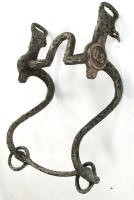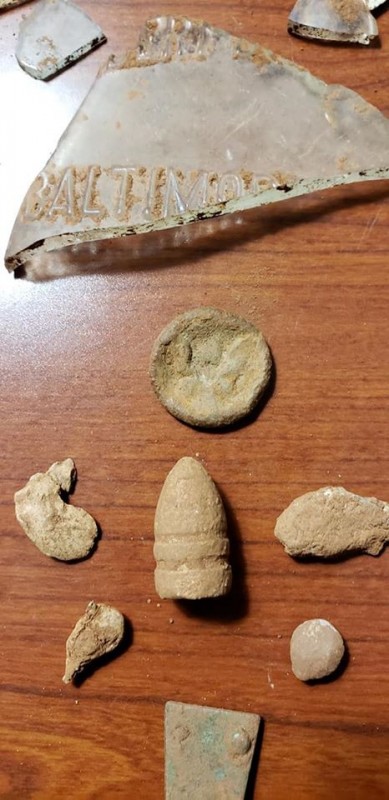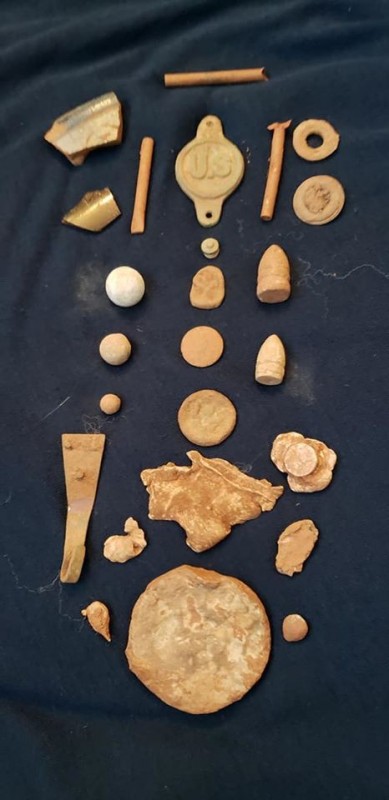-
Posts
6,133 -
Joined
-
Last visited
Content Type
Forums
Detector Prospector Home
Detector Database
Downloads
Everything posted by Chase Goldman
-

Vanquish Went Quiet Fast
Chase Goldman replied to Steve Herschbach's topic in Minelab Metal Detectors
I know that stating the Simplex is on par with an F75 is perhaps a bit of a stretch, but only a bit and for 95% of situations, I suspect the Simplex can hold its own against an F75 user using similar coils. Don't sell the Simplex short. Phrunt somewhat debunked the first statement regarding the bells and whistles and the Simplex modes are not just "tone" options, they are signal processing mode options that go beyound the comparatively less sophisticated process modes on the F75 including the ability to go potentially deep AND fast. My F75 was lapped easily by the Equinox 600 and has not really seen the light of day since the 800 arrived at my door. I now have the opportunity to do so some A to B comparisons and if Nokta provides the adfitional accessory coils, as promised, I will lose the last remaining legitimate reason I keep my F75 around. -

Vanquish Ground Balance Control?
Chase Goldman replied to coinhunterseth's topic in Minelab Metal Detectors
Multi frequency (Multi IQ) inherently provides the ability to do some "on-the-fly" ground compensation for both soil and salt beach wet sand. It is not as sophisticated as dedicated auto ground balance or ground tracking used on single frequency machines or even the Multi IQ-based Equinox. It is more like Multi IQ is very forgiving to a less than optimal default ground balance. As such, there is NO dedicated ground balance setting feature associated with the Vanquish as far as I can tell from the released detector information and user guide documentation. https://www.minelab.com/#product-download-category-files-305749 -
I don't know, I was really pretty happy with my Tek Delta and still own it. My Simplex should be here soon, too.
-

Vanquish Went Quiet Fast
Chase Goldman replied to Steve Herschbach's topic in Minelab Metal Detectors
I know your statement is tongue-in-cheek and a humorous jab grounded in some level of truth, but ML does not corner the market on delayed releases. The first (and last) detector I ever pre-paid/pre-ordered was the Nokta Impact. Ended up prying my $$ back from the dealer and cancelling my order when the promised March release languished into May. XP subsequent Deus promised (through official XP marketing material announcements) upgrade releases lingered for months and in one case for more than a year. A lot of hoopla months before the lukewarm Garrett AT series upgrade, the AT Max, finally came to market. The Whites MX Sport release debacle is painfully fresh in my mind. And how long have we been talking about the "imminent" release of the latest FT PI offering? Not defending ML, my only point being that all the leading manufacturers suffer from this issue and also have a track record for delays and those of us who anxiously await the next best thing in detectors are an impatient lot, which seems to make the wait that much worse. That being said, I am definitely not waiting for the the Vanquish to show up and other than the coil selection as an Equinox owner am not all that interested, but am really looking forward to getting my hands on the new Simplex (here soon, yes it was not an "Impact" situation, thankfully). My first Nokta machine that appears to be a great value-based compliment to my Deus/Equinox arsenal. Would like to bounce its performance off my venerable F75 and whites MXT, my only two remaining fixed single frequency machines. -
Also, conductivity is not the only material electromagnetic related property the determines the degree of phase shift that is used to determine target ID, though it is probably the most dominant.
-
EMI Primer EMI can affect Equinox use one of three ways: It can enter via the coil (most common for high power EMI souces such as power lines or other detectors), via the control head (most common from cell phones or other near field sources) and finally via the wireless phones (rare but not impossible). First line of defense for continuous noise or nearby pinpointer or detector interference is a noise cancel. This is especially effective if the source is another Equinox. With the 800 you have the option of either auto or manual noise cancel. Try manual to select a quiet channel if auto is ineffective. Remember that noise cancel is mode specific because of the various mode dependent frequency profiles, so you have to do it separately for any mode you use during the session. Second line of defense is lower sensitivity. Lower gradually until the chatter just disappears. If you are uncomfortable with a significantly lowered sensitivity setting, then... Third line of defense is switch modes or switch to single frequency (higher single frequencies tend to be less EMI sensitive) and attempt to find a quiet option. Beach modes are the least sparky modes (Beach 2 least of all), followed by Park 1, Field 1, Field 2, Park 2, and finally the Gold modes. Lowering recovery speed can sometimes help but at the expense of potentially increasing ground noise, which could be overcome by increasing sweep speed and/or doing a ground balance. Switching to a less RF sensitive coil (i.e., smaller antenna) although that can backfire if the coil resonant frequency (determined by the coil dimensions not the detector operating frequency) happens to be close to the EMI frequency. Switching to the 6 inch coil will not work if the EMI is entering the detector via the contro head. If you are getting interference through the wireless phones, switch to the WM08 or plug your wired phones directly into the detector. HTH
-
After you have initially paired the phones and then have turned off the machine and phones., what sequence do you go through when you turn the machine on again? I usually turn on the phones then turn on the machine, let it go through its initialization process and wait for the phones to reconnect, it can take anywhere from a few seconds to up to 30 seconds for the previously paired phones to reconnect (and for subsequent reconnection sessions, you should not have to press the radio button again (putting the EQ in pairing mode) or put the phones in pairing mode after the initial successful pairing unless the machine has been reset or another set of phones have been paired). Try varying the sequence of turning the phones on first or the EQ on first to se which provides a more consistent and reliable re-connection sequence. Also, update to the latest firmware if you haven't already done so. I may be imagining things, but my phones seem to reconnect a little faster now. Also, make sure the bt phones are not attempting to pair with your cell phone or other nearby bt devices. If you still can't seem to reliably re-connect the phones after successful pairing, you should call ML. HTH.
-
Can you walk through the pairing procedure step by step for both the EQ and the phones. You are right that it shouldn't be that difficult, and it generally is not and I have used a number of different APTX LL brands to test with the EQ.
-
It is a brass piece of horse tack stamped "U.S" that is fastened to the bit that is connected to the bridle/reins on a mounted cavalry horse.
- 13 replies
-
- xp deus
- minelab gpx
-
(and 1 more)
Tagged with:
-
The soil was extremely hot. There were areas of extreme iron trash and square nails abounded.. Not a lot of modern trash though. The attached pic will give you some idea and that is only from Day 1.
- 13 replies
-
- xp deus
- minelab gpx
-
(and 1 more)
Tagged with:
-
Did some CW relic hunting in Virginia this week using a variety of detectors including a GPX, Equinox 800, and a Deus and came away with some great relic finds. In a single hole I found a lead disc which is a possible backing to breast plate, part of a sword belt hanger, a dropped Sharps minie ball, and a purposely flattened Eagle I Coat button (possible poker chip) along with some glass and plate shards including a piece that had the word "Baltimore" on it. the Equinox got me into that hole, probably due to the lead disc, despite terribly hot soil. At another site, I hit my bucket lister, my first US Cavalry bit boss along about a foot down using a GPX 4800 with some other dropped and fired bullets and balls, some cannon friction primers, and other pieces of brass including a flat button found elsewhere in the fields. All in all, it was a great week with that bit boss being the highlight. Thanks for stopping by.
- 13 replies
-
- xp deus
- minelab gpx
-
(and 1 more)
Tagged with:
-
That is awesome, and unlike the sure grip, it doesn't interfere as much with getting your thumb up on the control panel. Great job, Dan.
-

Need Help With Identification
Chase Goldman replied to Joel's topic in Metal Detecting For Coins & Relics
Ok will give it a shot. -

Need Help With Identification
Chase Goldman replied to Joel's topic in Metal Detecting For Coins & Relics
Try posting to ID Me on FB. If not a FB fan, I can post it for you. -
At Steve's site, everything can be learned by reading what's here. Erik, for what you are trying to do, I highly recommend you consider the versatile Minelab Equinox, it will accomplish everything you want to do and hope to do on the beach with a single detector that can combine the positves of both detectors you mentioned in your post and then some. Even the forthcoming ML Vanquish 440 could get it done.
-
Make sure you are properly differentiating between EMI/noise, ground noise, and ferrous falsing. I don't find the 6" to be noisier from an EMI susceptibility standpoint, in fact just the opposite. But I do find it falses more than the 11" on small iron. The latest firmware update with the new F2 iron bias setting at about 5 or 6 has taken care of that issue. So you might want to give that a shot to quiet things down. If you are getting constant chatter with the coil lifted off the ground (e.g., at waist height or higher) and you can make it go away by lowering sensitivity - that is likely EMI. You can try doing an auto noise cancel but unless the noise source is constant and at specific frequencies like crackling power lines or florescent lighting or another nearby Equinox then noise cancel may not be very effective, especially if the source is intermittent. If auto noise cancel is ineffective, you can try manually selecting the quietest channel using manual noise cancel (see your manual on how to do this, manual noise cancel is only available on the 800). Stronger Broad band noise and/oir intermittent noise is harder to deal with and noise cancel is usually minimally effective. These sources include your cell phone (keep it off, in airplane mode, and/or away from the control head of the detector), wifi, walkie talkies, microwaves, invisible dog fences, etc. In that case you need to lower sensitivity. If you feel you have to lower sensitivity TOO MUCH to make the chatter stop, then try switching modes to see if another mode is less sensitive to the noise. If that fails, then try switching to single frequency to see if you can find one of the 5 frequencies (Park and Field modes) to be less sensitive to the noise (or 20 or 40 khz in Gold Mode). You would be surprised at how much depth you can get even at sensitivities less than 15. Ground noise shows up as chatty iron signals in the range of -9 to -7 VDI while swinging over the ground in all metal. If you are experiencing that, you should ground balance the detector. Also, as a reminder, noise cancel and ground balance settings are mode specific. For example, if you Noise cancel and GB in Park 1 and subsequently shift to another mode like Park 2, you have to noise cancel and ground balance for that mode too. Falsing results when the detector gets fooled by ferrous or mixed ferrous targets and sounds off with high tones. This usually happens with large iron, especially large round iron and with small bent square nails or square nail heads. Iron bias, especially the new F2 setting can help with this. The only drawback to using iron bias is that if you set it too high, it can mask actual non-ferrous targets in the proximity of iron. I have found that setting F2 around 4 to 6 is pretty effective and a good tradeoff setting against masking. The old FE iron bias setting seemed to be less effective (I usually left it at 0). Not only is the new F2 filter more effective, it also seems to target iron better with less masking than the FE filter as long as you keep it between 4 and 6. I have found that if you run F2 less than 3 or so, things get more "falsy". If iron is really thick, a way to combat the "iron overload" is to lower sensitivity. You will limit depth but some of the shallower non-ferrous keeper targets may pop out of the ferrous muck that way (the term I like to use for this technique is called "sifting"). Not sure if these apply to your situation but thought I would mention them. HTH and Happy Hunting with that 6-inch coil.
-
Nope, it’s a DD. The other funny thing is the F75 and T2 DD coils are NOT cross compatible (doh!). I keep an F75 around simply because it is compatible with concentric coils plus it sported the best all around ergonomics of any detector I ever used. (I keep my Whites MXT around because I loved the analog controls) - both are basically museum pieces now. They are like Nigel Tufnel’s Spinal Tap guitar collection - I cherish them, but no longer use them. 90% chance Nokta comes out with a small concentric for Simplex just like they have for the Anfibio, Kruzer, and Impact. ML has a slight edge in overall detecting technology with Multi IQ. Nokta is building solid performing units with features that are requested by their customers, if they come out with a multi frequency tech that rivals multi IQ, watch out. XP has a a solid alternate, completely wireless and light/compact detector design that kills in thick iron but they need to break through in the multi frequency game too and become more affordable to stay relevant. Everyone else is on the outside looking in becoming less and less relevant with every new release by the other guys due to their outdated concepts and tech or clunky designs and comparatively expensive price tags for what you are getting. Sad to see it.
-
Forgot about your multicolored rods, Steve. Lol. Need ML to get with the program and produce a blue head unit. Lol.
-
Vanquish shows ML too is making a play for the low cost but capable detector market, practically taking on the Garrett Ace series head on. Brand loyalty is not going to expand the Garrett, FT, or Whites user base, especially if they are not releasing anything new AND compelling. They should be concerned if they don’t have a reply to Simplex or Vanquish already in the works.
-
It would be kinda cool if the whole detector were that color.
-
I have no problem using other peoples settings as long as I know WHY the settings are what they are. I like to experiment with things to see if they work for me. But if I don't have a clue as to why a person is setting their machine up the way they are that means one of two things to me - either they don't know the machine or I don't know the machine. I have to figure out which of those it is and learn accordingly. You also need to know what those settings supposedly can do for you over and above what you already use. This goes hand in hand with understanding what the settings do in the first place. Because you can't understand how those settings can help if you don't understand WHY the person putting the settings out there did what they did. I like the thought of experimenting with beach on land, and plan to do it a little next week, but that is because I understand what Beach 1 and 2 are supposed to do in their "normal" beach environment. They are low frequency biased modes (hence best suited to detecting higher conductive targets), they are also not very "reactive" or "hot" so that they can function in a stable manner in salt conditions. They compensate for black sand and ground phase variability by using an overload function to reduce transmit power and in the case of beach 2, the transmit power is further reduced by default. All these things may have advantages in mineralized soil. As far as the specific settings are concerned, I do not put too much stock in carbon copy settings. I saw a video walkthrough of Neil's settings done by someone else and they are dictating specific ground balance settings (1) and noise cancel channels (4) which is totally ridiculous if you know what is going on because those are site specific settings. I get the 50 tones setting and some of the other tone volume setup settings, recovery speed and iron bias and will just set up and experiment with beach mode in my own way because I know what those settings do and how they affect target signals. All I really needed to know is, "try giving beach mode a go on land and see how it goes". The specific settings receipe is really immaterial to me. Bottom line, if you don't understand the why's behind someone else's settings or what they bring to the table for your detecting situation, then you are just rolling the dice and hoping something good will happen, and we all know how that usually works out.
-

Minelab 800 Settings For Large Gold Targets
Chase Goldman replied to Boatman4009's topic in Minelab Equinox Forum
Sounds like you are looking for large, deep (>2 ft.) buried caches of gold (rather than natural gold nuggets) or other metallic treasure you need a completely different tool than a consumer grade metal detector. Detectors called "two-box" machines can do this (perhaps not as deep as 3 feet). But you really need to investigate detectors designed and used by contractors to find and map buried pipes and cables. Completely different animal than a consumer grade metal detector. Plus you need to know what you are doing, have the proper permissions, ensure you are not actually digging up utility equipment, etc. Also, you need to have done your research. This is not something you can use on the random off chance that you will find something. If you can narrow it down to a house sized plot of land with some high probability, then you might have a fighting chance. Good luck. -
The Garrett ATX and ML 4800 (GPX) use similar pulse induction (PI) technology and both can be used for natural gold detecting or for relics and coins. It is somewhat difficult to advise you as I am not sure of your experience level in detecting and what kind of soils you will be primarily detecting in. Sounds like ploughed fields. Unless the "treasures" are super deep or the soil conditions are challenging with lots of iron oxide mineralization, a PI detector may not be necessary, and a less expensive VLF induction balance machine might be more suitable to your circumstance (more about that later). The ATX has the advantage of being fully waterproof which means you can use it in the water or in foul weather without having to provide additional protection to the control box. The ML 4800 has better iron discrimination circuits than the ATX, is lighter, and the timings are more sophisticated for varying soil conditions which is really just an advantage for gold hunting. There are more accessory coil options for the ML 4800 than for the ATX. Since both use pulse induction technology, they will go deeper than your typical VLF induction balance detector which are more commonly used by those seeking coins and relics and are typically much less expensive than the ATX and ML GPX you are considering, unless the price is highly discounted because the unit is used. If you are seeking deep buried caches of treasure, I would lean towards the ML 4800 because its audio tends to give you a better "picture" of larger, deeper targets. If this is a hobby you are just embarking on, I highly recommend taking the advice of others here, and start out with a capable VLF machine like the Equinox 800. It is highly versatile and light weight and is simpler to operate and tune than a PI detector and if you find that the hobby is not something you want to pursue your investment is relatively small. It will perform well in all kinds of tough soil environments such as salt beaches and highly mineralized soils (where PI detectors also excel) If you really want to just dip your toe in the water with a capable detector with minimal investment, I recommend that you investigate using the Nokta Simplex detector. Which has just been released (so it may be difficult to find initially). It is low cost but appears to be very capable and straight forward to operate. Good luck.
-

How To Get A 7" X 10" Coil For Your Equinox
Chase Goldman replied to Steve Herschbach's topic in Minelab Equinox Forum
The only flaw in this analogy is that unlike screw drivers with interchangeable drivers where the handles are basically similar, the detector (the screwdriver handle in your analogy) capabilities vary significantly. I couldn't see myself getting a less capable detector model just because that detector has coil type that I cannot run on my preferred detector (though I have kept less capable detectors around because they can run concentric coils, and my primary detector can't, for example). All things being equal though, yeah it could sway my purchase decision. Also, while I am all for coil variety and would like to see the Vanquish coil series available for Equinox, I honestly have not found a situation where one of the three Equinox coils could not get the job done and I suppose most folks just run with stock coils anyway, so it is probably a problem only experienced detectorists care about, which is probably the minority of Equinox and Vanquish users.






